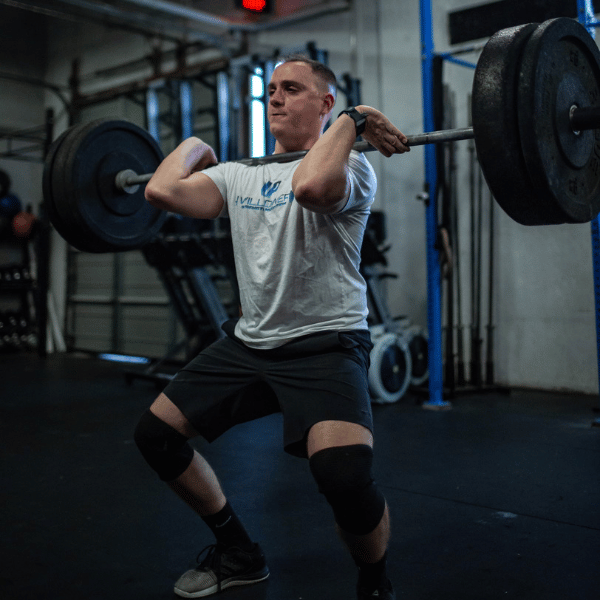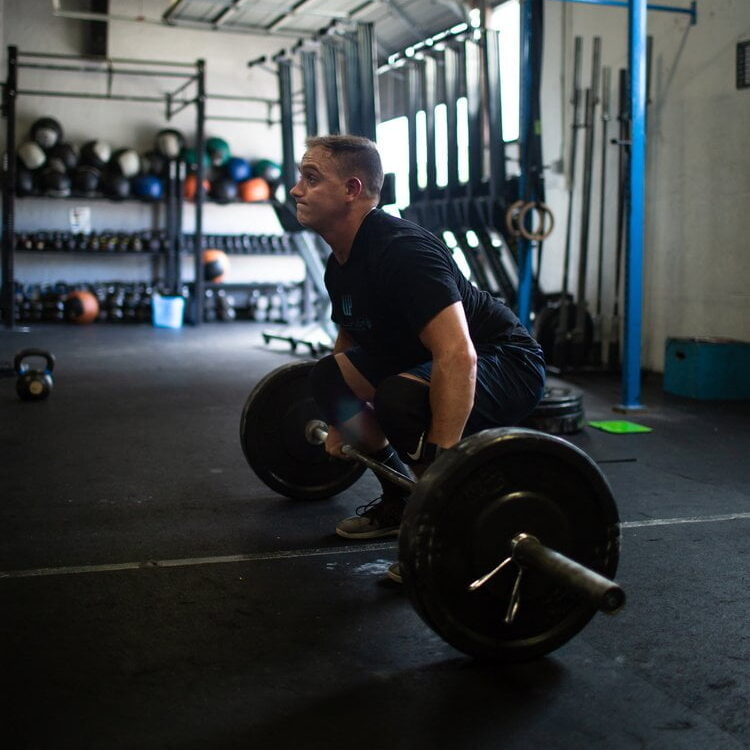The Best Strategy For The CrossFit Seven Workout
The CrossFit Seven workout is a brutal yet meaningful test of endurance, strength, and mental grit.
It consists of seven rounds of seven exercises, each demanding physical effort that pushes even the most seasoned CrossFit athletes to their limits.
However, this workout carries a significance far beyond just being a challenge; it is a Hero WOD, one of the many workouts created in tribute to fallen heroes.
“The Seven” was designed to honor the seven CIA officers who tragically lost their lives in a 2009 suicide bombing in Afghanistan.
In the world of CrossFit, Hero WODs are more than workouts—they are commemorative acts of respect for those who made the ultimate sacrifice, serving as a reminder that the challenges we face in the gym pale in comparison to the bravery of those who serve.
As a performance Physical Therapist and CrossFit coach for the last twelve years specializing in helping CrossFit athletes improve performance and train pain-free, I’ve performed and prescribed “the Seven” countless times.
In this article, we’ll outline the CrossFit seven workout, how to strategize it, and key tips on scaling to help you post your best time yet!
Legacy Behind The CrossFit Seven Workout
The origins of “The Seven WOD” is a CrossFit Hero WOD rooted in a tragic event that took place on December 30, 2009.
Seven CIA officers were killed by a suicide bomber at Forward Operating Base Chapman in southeastern Afghanistan.
In response, CrossFit crafted this Hero WOD as a way to honor their memory, allowing athletes to pay tribute through the physical and mental demands of the workout.
The number seven is symbolic throughout, representing both the officers and the structure of the workout itself.
Hero WODs are a core part of CrossFit’s culture, designed to commemorate fallen military personnel, first responders, and others who have sacrificed their lives in service.
These workouts are intentionally grueling, meant to be as mentally taxing as they are physically challenging.
They require athletes to push through pain, fatigue, and doubt—much like the real-world hardships faced by those they honor.
In this way, Hero WODs transcend regular fitness routines, turning workouts into solemn tributes.
CrossFit uses these Hero WODs to foster resilience.
By honoring the lives of fallen heroes through intense physical exertion, athletes are reminded of the strength, bravery, and perseverance it takes to serve in high-risk professions.
Completing a Hero WOD like “The Seven” is about paying homage to those who have given everything, and in doing so, finding strength within ourselves to overcome our own challenges—whether physical or mental.
What Is The “The Seven” Workout?
The CrossFit “Seven” workout is a formidable challenge that consists of seven different exercises, each performed in seven repetitions for seven rounds.
It has never been featured in any of the CrossFit Open workouts but has been seen in CrossFit’s workout of the day.
Athletes are required to complete all rounds for time, meaning they aim to finish the entire workout as quickly as possible without sacrificing form or safety.
7 Rounds For Time:
7 Handstand Push-ups
7 Thrusters (135 lbs for men / 95 lbs for women)
7 Knees-to-Elbows
7 Deadlifts (245 lbs for men / 175 lbs for women)
7 Burpees
7 Kettlebell Swings (2 pood for men / 1.5 pood for women)
7 Pull-ups
Athletes must complete seven rounds of these exercises, pushing through fatigue while maintaining proper technique.
The workout is typically performed with a 40-minute time cap, though seasoned athletes may finish faster.
The performance standard is straightforward: complete all reps and rounds as efficiently as possible without sacrificing form, which is key to avoiding injury during such a high-volume workout.
Scaling Options for Different Levels
“The Seven” is an incredibly challenging workout, but CrossFit emphasizes scalability, ensuring athletes of all levels can participate.
Scaling in smart ways allows beginners or those who are not yet at the prescribed (Rx) level to complete the workout while maintaining its intensity and spirit.
Here are common scaling options:
Lighter Weight for Thrusters and Deadlifts
Instead of using the Rx weights (135 lbs for thrusters and 245 lbs for deadlifts), athletes can scale down to a lighter, more manageable weight.
This reduces the risk of injury while still allowing athletes to work on strength and endurance.
For example, scaling the thrusters down to 75 lbs or the deadlifts to 155 lbs can make the workout more approachable for beginners.
Handstand Push-up Modifications
Handstand push-ups are an advanced movement that requires significant upper-body strength and balance.
A common scale for this exercise is pike push-ups, where athletes place their feet on a box or bench and perform a push-up with their hips elevated to mimic the handstand pushup position.
For an even easier option, athletes can perform regular push-ups until they build the strength for more advanced variations.
Scaling Pull-ups
Not everyone can perform strict pull-ups, so alternatives like jumping pull-ups or ring rows are excellent scaling options.
Jumping pull-ups use momentum to assist the movement, while ring rows allow athletes to adjust their body angle to decrease or increase difficulty.
Breaking Up Reps
For athletes struggling with endurance, breaking up the sets of 7 reps into smaller, more manageable sets—such as 4 and 3—can help prevent burnout and keep intensity high without overwhelming the athlete.
Athletes should scale the workout according to their current fitness level while keeping the goal in mind: to challenge both their mental and physical limits.
Even with scaling, “The Seven” remains a taxing workout that provides the same sense of accomplishment and tribute to the fallen heroes it honors.
Key Tips for Tackling “The Seven”
Pacing Yourself
“The Seven” is a long and grueling workout that can easily drain your energy if approached too aggressively on the first round. With seven rounds of high-intensity exercises, pacing is essential.
It’s tempting to go out fast, but that can lead to burnout before you’re halfway through.
Experienced athletes recommend starting at a controlled, steady pace—enough to push yourself but not so fast that you hit a wall early on.
Aim to keep a consistent pace, saving enough energy to finish strong in the later rounds.
Breaking Up Reps
Managing fatigue is a key strategy for success in “The Seven.” Movements like thrusters and handstand push-ups can become incredibly taxing as the rounds progress.
Instead of pushing through all 7 reps in one go, consider breaking them into smaller, manageable sets.
For example, splitting thrusters into 4-3 reps or breaking pull-ups into 2-2-2-1 reps can help avoid exhaustion while keeping you moving.
This method allows you to maintain intensity without compromising form, which is vital for safety and longevity in the workout.
Maintaining Proper Form
Your technique is everything in a workout like “The Seven,” especially when it involves heavy lifts like the deadlift and thruster. Poor form can lead to injury, particularly as fatigue sets in.
Focus on maintaining good posture and alignment in movements like the deadlift, where keeping a neutral spine and engaging your core are critical to protecting your lower back. (1)
The same goes for thrusters—ensure your squat is deep enough and your elbows stay high, allowing for a smooth transition to the overhead press.
By prioritizing proper form, you’ll not only avoid injury but also complete the workout more efficiently.
Why “The Seven” is More than Just a Workout
“The Seven” is not simply a test of physical fitness; it’s a Hero WOD that carries significant meaning and serves as a tribute to seven CIA officers who lost their lives in a 2009 suicide bombing in Afghanistan.
Like all Hero WODs, it’s designed to honor the sacrifices of those who have served and died, and completing the workout is meant to be a show of respect and remembrance.
Every rep, every round, symbolizes the commitment and courage of these individuals.
Performing “The Seven” honors the memory of the fallen officers by pushing athletes to experience the kind of endurance, resilience, and mental strength that embodies their service.
As the workout becomes tougher with each round, it reminds participants that this physical struggle is symbolic of the hardships and sacrifices others have endured.
It’s a way for CrossFitters to step outside themselves, to reflect on a deeper purpose while pushing their own limits.
More than just a personal challenge, Hero WODs foster community.
They unite people through shared effort and determination, offering a moment to pause and reflect on the larger picture beyond fitness goals.
When CrossFitters take on “The Seven,” they are not just completing a workout—they are honoring the memory of heroes, embracing a communal purpose, and demonstrating mental fortitude by enduring hardship in their own way.
This sense of shared purpose strengthens the bonds within the CrossFit community, creating an atmosphere where honoring sacrifice and resilience becomes a collective act of respect and tribute.
Final Thoughts on The Seven CrossFit Workout
“The Seven” is not just a workout; it’s a challenging Hero WOD designed to test both your physical and mental limits.
With seven intense movements performed over seven rounds, it demands endurance, strength, and resilience.
But beyond the sweat and effort, this workout holds a deeper significance—it’s a tribute to seven CIA officers who gave their lives in service.
Every round honors their sacrifice, making it more than just a grueling workout; it’s an act of remembrance.
If you’re a CrossFit athlete looking for a test of both your fitness and mental fortitude, I encourage you to give “The Seven” a try.
Approach it with respect, knowing that it’s designed to challenge you at every turn. And remember, it’s okay to scale the workout to your ability while keeping its essence and legacy alive.
The key is pushing your limits while staying mindful of the purpose behind it.
So, take on “The Seven” knowing that you’re not just building physical strength—you’re building mental resilience too.
Want to elevate your fitness and train pain-free?
If you’re looking for more ways to train smart and pain-free, subscribe to my free weekly newsletter to get access to my Bulletproof Training Program, designed to help you achieve peak performance while staying injury-free!
FAQ
What is the purpose of Hero WODs like “The Seven”?
Hero WODs are designed to honor fallen service members, first responders, and others who have made the ultimate sacrifice.
“The Seven” pays tribute to seven CIA officers who died in a 2009 suicide bombing in Afghanistan.
These workouts push athletes to their physical and mental limits as a way of reflecting on and honoring the bravery, endurance, and sacrifice of the individuals they represent.
How should I approach scaling “The Seven” workout if I’m a beginner?
If you’re new to CrossFit, trying the WOD for the first time or not yet ready to complete the workout as prescribed, there are several scaling options.
You can reduce the weight for thrusters and deadlifts, substitute handstand push-ups with pike or regular push-ups, and modify pull-ups to jumping pull-ups or ring rows.
The goal is to maintain the intensity while working within your fitness level.
How long does it typically take to complete “The Seven”?
“The Seven” is an intense and long workout, often performed with a time cap of 40 minutes.
Depending on your fitness level, experience, and strategy, it may take more or less time.
It’s important to pace yourself and focus on form to ensure a successful completion of the workout. a good time for the “The Seven” is between 25-35 minutes.
References:
1. Bengtsson, V., Aasa, U., Öhberg, F., & Berglund, L. (2022). Thoracolumbar And Lumbopelvic Spinal Alignment During The Deadlift Exercise: A Comparison Between Men And Women. International journal of sports physical therapy, 17(6), 1063–1074. https://doi.org/10.26603/001c.37859







